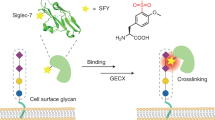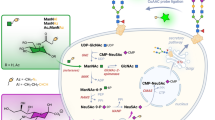Abstract
Transient interactions among glycoconjugates underlie developmental, immunological and metastatic recognition. Glycan-mediated interactions have low binding affinities and rapid dissociation rates. As a result, these complexes dissociate when removed from their cellular context, complicating characterization. Photocrosslinkers introduce a covalent bond between glycoconjugates and their binding partners, allowing physiologically relevant complexes to be isolated. This protocol describes metabolic incorporation of a diazirine photocrosslinker into sialic acids in cellular glycoconjugates. Subsequent irradiation results in photocrosslinking of sialic acid to neighboring macromolecules, providing a photochemical 'snapshot' of binding events. As photocrosslinking sugars are light activated, these reagents have the potential to be used for temporally and/or spatially restricted crosslinking. We provide instructions for the synthesis of photocrosslinking sugar precursors, cell culture for metabolic incorporation, flow cytometry to evaluate metabolic incorporation, photoirradiation and analysis of the crosslinked complexes. Synthesis of photocrosslinking sugars requires 4–6 d, and photocrosslinking experiments can be completed in an additional 6 d.
This is a preview of subscription content, access via your institution
Access options
Subscribe to this journal
Receive 12 print issues and online access
$259.00 per year
only $21.58 per issue
Buy this article
- Purchase on Springer Link
- Instant access to full article PDF
Prices may be subject to local taxes which are calculated during checkout






Similar content being viewed by others
References
Haltiwanger, R.S. & Lowe, J.B. Role of glycosylation in development. Annu. Rev. Biochem. 73, 491–537 (2004).
van Kooyk, Y. & Rabinovich, G.A. Protein–glycan interactions in the control of innate and adaptive immune responses. Nat. Immunol. 9, 593–601 (2008).
Vollmers, H.P. & Brandlein, S. Tumors: too sweet to remember? Mol. Cancer 6, 78 (2007).
Campbell, C.T., Sampathkumar, S.G. & Yarema, K.J. Metabolic oligosaccharide engineering: perspectives, applications, and future directions. Mol. Biosyst. 3, 187–194 (2007).
Dube, D.H. & Bertozzi, C.R. Metabolic oligosaccharide engineering as a tool for glycobiology. Curr. Opin. Chem. Biol. 7, 616–625 (2003).
Tanaka, Y. & Kohler, J.J. Photoactivatable crosslinking sugars for capturing glycoprotein interactions. J. Am. Chem. Soc. 130, 3278–3279 (2008).
Han, S., Collins, B.E., Bengtson, P. & Paulson, J.C. Homomultimeric complexes of CD22 in B cells revealed by protein–glycan cross-linking. Nat. Chem. Biol. 1, 93–97 (2005).
Yu, H. & Chen, X. Carbohydrate post-glycosylational modifications. Org. Biomol. Chem. 5, 865–872 (2007).
Collins, B.E. et al. High-affinity ligand probes of CD22 overcome the threshold set by cis ligands to allow for binding, endocytosis, and killing of B cells. J. Immunol. 177, 2994–3003 (2006).
Kelm, S., Gerlach, J., Brossmer, R., Danzer, C.-P. & Nitschke, L. The ligand-binding domain of CD22 is needed for inhibition of the B cell receptor signal, as demonstrated by a novel CD22-specific inhibitor compound. J. Exp. Med. 195, 1207–1213 (2002).
Kelm, S. et al. Functional groups of sialic acids involved in binding siglecs (sialoadhesins) deduced from interactions with synthetic analogues. Eur. J. Biochem. 255, 663–672 (1998).
Collins, B.E., Fralich, T.J., Itonori, S., Ichikawa, Y., Schnaar, R.L . Conversion of cellular sialic acid expression from N-acetyl to N-glycolylneuraminic acid using a synthetic precursor, N-glycolylmannosamine pentaacetate: inhibition of myelin-associated glycoprotein binding to neural cells. Glycobiology 10, 11–20 (2000).
Varki, A. Radioactive tracer techniques in the sequencing of glycoprotein oligosaccharides. FASEB J. 5, 226–235 (1991).
Aich, U. et al. Regioisomeric SCFA attachment to hexosamines separates metabolic flux from cytotoxicity and MUC1 suppression. ACS Chem. Biol. 3, 230–240 (2008).
Zhao, W., Chen, T.L., Vertel, B.M. & Colley, K.J. The CMP-sialic acid transporter is localized in the medial-trans Golgi and possesses two specific endoplasmic reticulum export motifs in its carboxyl-terminal cytoplasmic tail. J. Biol. Chem. 281, 31106–31118 (2006).
Kayser, H. et al. Biosynthesis of a nonphysiological sialic-acid in different rat organs, using N-propanoyl-D-hexosamines as precursors. J. Biol. Chem. 267, 16934–16938 (1992).
Jacobs, C.L. et al. Substrate specificity of the sialic acid biosynthetic pathway. Biochemistry 40, 12864–12874 (2001).
Dafik, L., d'Alarcao, M. & Kumar, K. Fluorination of mammalian cell surfaces via the sialic acid biosynthetic pathway. Bioorg. Med. Chem. Lett. 18, 5945–5947 (2008).
Pon, R.A., Biggs, N.J. & Jennings, H.J. Polysialic acid bioengineering of neuronal cells by N-acyl sialic acid precursor treatment. Glycobiology 17, 249–260 (2007).
Sampathkumar, S.G., Li, A.V., Jones, M.B., Sun, Z. & Yarema, K.J. Metabolic installation of thiols into sialic acid modulates adhesion and stem cell biology. Nat. Chem. Biol. 2, 149–152 (2006).
Luchansky, S.J. & Bertozzi, C.R. Azido sialic acids can modulate cell-surface interactions. Chembiochem 5, 1706–1709 (2004).
Horstkorte, R., Rau, K., Laabs, S., Danker, K. & Reutter, W. Biochemical engineering of the N-acyl side chain of sialic acid leads to increased calcium influx from intracellular compartments and promotes differentiation of HL60 cells. FEBS Lett. 571, 99–102 (2004).
Horstkorte, R., Rau, K., Reutter, W., Nohring, S. & Lucka, L. Increased expression of the selectin ligand sialyl-Lewis(x) by biochemical engineering of sialic acids. Exp. Cell. Res. 295, 549–554 (2004).
Luchansky, S.J. et al. Constructing azide-labeled cell surfaces using polysaccharide biosynthetic pathways. Methods Enzymol. 362, 249–272 (2003).
Saxon, E. & Bertozzi, C.R. Cell surface engineering by a modified Staudinger reaction. Science 287, 2007–2010 (2000).
Schmidt, C., Stehling, P., Schnitzer, J., Reutter, W. & Horstkorte, R. Biochemical engineering of neural cell surfaces by the synthetic N-propanoyl-substituted neuraminic acid precursor. J. Biol. Chem. 273, 19146–19152 (1998).
Wieser, J.R., Heisner, A., Stehling, P., Oesch, F. & Reutter, W. In vivo modulated N-acyl side chain of N-acetylneuraminic acid modulates the cell contact-dependent inhibition of growth. FEBS Lett. 395, 170–173 (1996).
Chefalo, P., Pan, Y., Nagy, N., Guo, Z. & Harding, C.V. Efficient metabolic engineering of GM3 on tumor cells by N-phenylacetyl-D-mannosamine. Biochemistry 45, 3733–3739 (2006).
Oetke, C. et al. Versatile biosynthetic engineering of sialic acid in living cells using synthetic sialic acid analogues. J. Biol. Chem. 277, 6688–6695 (2002).
Luchansky, S.J., Goon, S. & Bertozzi, C.R. Expanding the diversity of unnatural cell-surface sialic acids. Chembiochem 5, 371–374 (2004).
Oetke, C. et al. Evidence for efficient uptake and incorporation of sialic acid by eukaryotic cells. Eur. J. Biochem. 268, 4553–4561 (2001).
Keppler, O.T. et al. UDP-GlcNAc 2-epimerase: a regulator of cell surface sialylation. Science 284, 1372–1376 (1999).
Kikuchi, K. & Tsuiki, S. Purification and properties of UDP-N-acetylglucosamine 2′-epimerase from rat liver. Biochim. Biophys. Acta. 327, 193–206 (1973).
Schwarzkopf, M. et al. Sialylation is essential for early development in mice. Proc. Natl. Acad. Sci. USA 99, 5267–5270 (2002).
Ghosh, S. & Roseman, S. The sialic acids. V. N-Acyl-D-glucosamine 2-epimerase. J. Biol. Chem. 240, 1531–1536 (1965).
Maru, I., Ohta, Y., Murata, K. & Tsukada, Y. Molecular cloning and identification of N-acyl-D-glucosamine 2-epimerase from porcine kidney as a renin-binding protein. J. Biol. Chem. 271, 16294–16299 (1996).
Takahashi, S. et al. Human renin-binding protein is the enzyme N-acetyl-D-glucosamine 2-epimerase. J. Biochem. 125, 348–353 (1999).
Tanaka, Y., Bond, M.R. & Kohler, J.J. Photocrosslinkers illuminate interactions in living cells. Mol. BioSyst. 4, 473–480 (2008).
Blencowe, A. & Hayes, W. Development and application of diazirines in biological and synthetic macromolecular systems. Soft Matter 1, 178–205 (2005).
Wittelsberger, A., Thomas, B.E., Mierke, D.F. & Rosenblatt, M. Methionine acts as a 'magnet' in photoaffinity crosslinking experiments. FEBS Lett. 580, 1872–1876 (2006).
Church, R. & Weiss, M. Diazirines. II. Synthesis and properties of small functionalized diazirine molecules. Some observations on the reaction of a diaziridine with the iodine-iodide ion system. J. Org. Chem. 35, 2465–2471 (1970).
Hong, Y. & Stanley, P. Lec3 Chinese hamster ovary mutants lack UDP-N-acetylglucosamine 2-epimerase activity because of mutations in the epimerase domain of the Gne gene. J. Biol. Chem. 278, 53045–53054 (2003).
Ito, M., Ikeda, K., Suzuki, Y., Tanaka, K. & Saito, M. An improved fluorometric high-performance liquid chromatography method for sialic acid determination: an internal standard method and its application to sialic acid analysis of human apolipoprotein E. Anal. Biochem. 300, 260–266 (2002).
Shibuya, N. et al. The elderberry (Sambucus nigra L.) bark lectin recognizes the Neu5Ac(α2–6)Gal/GalNAc sequence. J. Biol. Chem. 262, 1596–1601 (1987).
Chokhawala, H.A. et al. Combinatorial chemoenzymatic synthesis and high-throughput screening of sialosides. ACS Chem. Biol. 3, 567–576 (2008).
Lis, H., Joubert, F.J. & Sharon, N. Isolation and properties of N-acetyllactosamine-specific lectins from nine Erythrina species. Phytochemistry 24, 2803–2809 (1985).
Osinaga, E. et al. Amino acid sequence and three-dimensional structure of the Tn-specific isolectin B4 from Vicia villosa. FEBS Lett. 412, 190–196 (1997).
Jones, M.B. et al. Characterization of the cellular uptake and metabolic conversion of acetylated N-acetylmannosamine (ManNAc) analogues to sialic acids. Biotechnol. Bioeng. 85, 394–405 (2004).
Luchansky, S.J., Yarema, K.J., Takahashi, S. & Bertozzi, C.R. GlcNAc 2-epimerase can serve a catabolic role in sialic acid metabolism. J. Biol. Chem. 278, 8035–8042 (2003).
Acknowledgements
We thank Michael Pawlita (German Cancer Research Center) and James Paulson (The Scripps Research Institute) for sharing BJAB K20, BJAB K88, HL60-I and HL60-II cells, and Ellen Vitetta (UT Southwestern Medical Center) for sharing Daudi cells. We thank Yan Li (UT Southwestern Medical Center Protein Chemistry Technology Center) for mass spectrometry analysis of sugars and Angela Mobley (UT Southwestern Medical Center Flow Cytometry Core Facility) for help with flow cytometry. We thank Dr Yoshihito Tanaka and Dr Seokho Yu for advice on synthesis. M.R.B. acknowledges the support of an NSF graduate fellowship and Stanford University. This work was supported by funds from a March of Dimes Basil O'Connor Starter Scholar Award, the Welch Foundation and the University of Texas Southwestern Medical Center.
Author information
Authors and Affiliations
Corresponding author
Rights and permissions
About this article
Cite this article
Bond, M., Zhang, H., Vu, P. et al. Photocrosslinking of glycoconjugates using metabolically incorporated diazirine-containing sugars. Nat Protoc 4, 1044–1063 (2009). https://doi.org/10.1038/nprot.2009.85
Published:
Issue Date:
DOI: https://doi.org/10.1038/nprot.2009.85
This article is cited by
-
Metabolic glycan labelling for cancer-targeted therapy
Nature Chemistry (2020)
-
Cellular metabolism of unnatural sialic acid precursors
Glycoconjugate Journal (2015)
-
Synthesis of bioorthogonal and crosslinking amino acids for use in peptide synthesis
Amino Acids (2010)
Comments
By submitting a comment you agree to abide by our Terms and Community Guidelines. If you find something abusive or that does not comply with our terms or guidelines please flag it as inappropriate.



